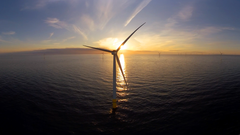Ørsted and UC Berkeley's Haas School of Business team up to advance people-positive renewable energy build-out
Ørsted, one of the world's leading renewable energy companies, and Haas School of Business at the University of California, Berkeley, have entered a multi-year partnership to advance the positive social impact of renewable energy projects.
Ørsted and UC Berkeley's Haas School of Business will bring together community organisations, policymakers, and industry experts to lay the foundation for people-positive renewable energy.

To limit global warming, yearly renewable energy additions must increase 3.3x per year by 2030[1].
According to their 2023 report, the Intergovernmental Panel on Climate Change (IPPC) emphasised the vital importance of ensuring that the renewable energy transition occurs at the necessary pace and scale, while also bringing value to people and communities[2].
Scaling up the deployment of renewable energy represents a substantial opportunity for positive social impact tied to employment, workforce development, environmental justice, and public health. Community support for hosting renewable energy and partnering in the build-out will be increasingly important as the energy transition accelerates.
As the world's first energy company with a validated long-term science-based net-zero target and with a commitment to ensuring a net-positive biodiversity impact, Ørsted intends to leverage its industry-leading sustainability commitments and expertise to play a role in defining universal standards for promoting positive social impact as well.
Aim: Boosting the positive social impact of renewable energy
The new partnership between Ørsted and Haas School of Business at the University of California, Berkeley, aims to lay out the foundations for a standardised industry framework on social impacts of renewable energy projects. This framework could include factors such as quality employment, education, inclusion, health, community engagement, and others.
The aim of the framework is to boost the positive social impact arising from the development of renewable energy and allow renewable energy customers, governments, and the financial community to assess the social value of these projects.
Ingrid Reumert, Senior Vice President, and Head of Global Stakeholder Relations at Ørsted, says:
“At Ørsted, our vision is to create a world powered entirely by green energy, where our company gives back more to society and nature than it takes. We prioritise making a positive impact on the lives of those living and working near our wind and solar farms. Through our collaboration with Haas, we aim to set common criteria for people-positive renewable energy, fostering awareness and action within our industry to enhance the well-being of people and communities around our assets.”
Finding the best ways to partner with and deliver value to people
At present, Ørsted operates 15.5 GW of renewable energy assets, while 4.9 GW are under construction across technologies.
In the expansion of global renewable energy, Ørsted collaborates as a trusted partner with local communities, offering benefits such as quality jobs, training, education, supply chain development, and biodiversity restoration.
The ‘Wind Power Ready’ Programme recruits from local communities
One recent example of Ørsted's social sustainability approach is the 'Wind Power Ready' programme in the United States. This programme actively recruits candidates from communities where Ørsted is developing projects and provides paid training and support services that connect them to wind farm technician careers.
This initiative was developed in partnership with the Rowan College of South Jersey and other state and community organisations with the goal of hiring wind farm technicians from the Atlantic City, New Jersey area. By investing in people from communities near Ørsted’s operations and maintenance facilities, Wind Power Ready strives to address historical inequities and provide individuals with access to secure, well-paid, and long-term career opportunities.
Ørsted was also the first offshore wind developer to commit to using union labour for the construction of its offshore wind projects through the industry-leading National Offshore Wind Agreement (NOWA) between Ørsted and North America’s Building Trades Unions (NABTU). The agreement includes training and employment provisions to increase union construction workforce capabilities, foster a diverse, equitable, and inclusive workforce with diversity targets, provides local training programmes and workforce diversity performance monitoring, and expand opportunities in offshore wind to frontline communities.
Pamela Farrell Venzke, Chief Corporate Affairs Officer of Region Americas at Ørsted, says:
“The clean energy build-out will be a major transformation of our energy infrastructure, and it comes with an opportunity and a responsibility to deliver a broad set of benefits to people and nature. The energy transition will create tens of thousands of jobs, drive economic growth, and create family-sustaining employment. We’re excited to partner with UC Berkeley's Haas School of Business, a leader in corporate sustainability research, to advance our own social sustainability practice and further pave the way for the industry to deliver more value to people."
Academic research, stakeholder round-tables, and business case studies
As part of this partnership, the UC Berkeley's Haas School of Business and Ørsted will convene public and private sector experts for a meeting to define the first building blocks for measuring the people-positivity of renewable energy projects.
Through academic research, stakeholder round-tables, and business case studies, the partnership will initiate a worldwide dialogue concerning the necessity of and approach to assessing and comparing the total social impact of renewable energy assets, ultimately leading to a people-positive build-out.
Ann E. Harrison, Dean of Haas School of Business at the University of California, Berkeley, says:
“As a recognised business school leader in sustainability teaching and thinking, we’re excited to work with the renewable energy company Ørsted. Haas aims to equip the next generation of business leaders to tackle the world's most pressing sustainability challenges and lead businesses that have a positive environmental and social impact. This multi-year partnership with Ørsted, a recognised leader in global sustainability, aligns with that mission.”
Read more about how Ørsted provides green energy here.
Read more about the Wind Power Ready programme here.
Read more about the Center for Responsible Business at Berkeley Haas here.
For more information, please contact:
Ørsted Global Media Relations
Thor R. Wilkens
+45 99 55 44 07
thrwi@orsted.com
Ørsted US Media Relations
Ryan Ferguson
+1 8572686558
ryfer@orsted.com
Berkeley Haas Media Relations
Kim Girard
kim_girard@berkeley.edu
About Ørsted
The Ørsted vision is a world that runs entirely on green energy. Ørsted develops, constructs, and operates offshore and onshore wind farms, solar farms, energy storage facilities, renewable hydrogen and green fuels facilities, and bioenergy plants. Ørsted is recognised on the CDP Climate Change A List as a global leader on climate action and was the first energy company in the world to have its science-based net-zero emissions target validated by the Science Based Targets initiative (SBTi). Headquartered in Denmark, Ørsted employs approx. 8,700 people. Ørsted's shares are listed on Nasdaq Copenhagen (Orsted). In 2022, the group's revenue was DKK 132.3 billion (EUR 17.8 billion). Visit orsted.com or follow us on Facebook, LinkedIn, Instagram, and Twitter.
1. IRENA, 2023: World Energy Transitions Outlook.
2. IPCC, 2023: Climate Change 2023: Synthesis Report. A Report of the Intergovernmental Panel on Climate Change. Contribution of Working Groups I, II and III to the Sixth Assessment Report of the Intergovernmental Panel on Climate Change [Core Writing Team, H. Lee and J. Romero (eds.)]. IPCC, Geneva, Switzerland, (in press)
Images

Documents
Alternative languages
Subscribe to releases from Ørsted A/S
Subscribe to all the latest releases from Ørsted A/S by registering your e-mail address below. You can unsubscribe at any time.
Latest releases from Ørsted A/S
Ørsted bliver det første energiselskab i verden, som gennemfører grøn omstilling med en CO2-reduktion på 98 %12.11.2025 07:59:58 CET | Pressemeddelelse
Mens verdens ledere er samlet i Brasilien til COP30, markerer Ørsted en milepæl. Med en reduktion af selskabets CO2-udledning på 98 % bliver Ørsted det første energiselskab i verden, der når sit industriførende og videnskabeligt baserede 2025-klimamål.
SBTi approves Ørsted’s strengthened pathway to net-zero in 204030.1.2025 12:30:00 CET | Press release
Ørsted has set new 2030 climate targets to enhance visibility on the actions needed to reach its science based 2040 net-zero target. The 2030 targets, which cover the full value chain emissions (scope 1-3) and align with the 1.5C pathway, have now been formally approved by the Science Based Targets initiative (SBTi).
SBTi godkender Ørsteds styrkede indsats mod netto-nul i 204030.1.2025 12:30:00 CET | Pressemeddelelse
Ørsted har sat nye klimamål for 2030 for at øge synligheden af de indsatser, der er nødvendige, for at virksomheden kan nå sit videnskabeligt baserede mål for netto-nuludledning i 2040. Målene for 2030, der dækker CO2-udledningen i hele værdikæden (scope 1-3) og er i overensstemmelse med 1,5 °C-scenariet, er nu formelt godkendt af Science Based Targets initiative (SBTi).
Ørsted has completed 600 MW combined solar and battery storage project in the US11.10.2024 08:00:00 CEST | Press release
With a 300 MW solar PV capacity, Ørsted’s Eleven Mile Solar Center will produce enough renewable energy to power 65,000 US homes while the battery can store 1200 MWh of power.
Ørsted har idriftsat 600 MW kombineret sol- og batterilagringsprojekt i USA11.10.2024 08:00:00 CEST | Pressemeddelelse
Med en solenergikapacitet på 300 MW vil Ørsteds Eleven Mile Solar Center producere nok vedvarende energi til at forsyne 65.000 husstande i USA med strøm, mens batteriet kan lagre 1.200 MWh strøm.
In our pressroom you can read all our latest releases, find our press contacts, images, documents and other relevant information about us.
Visit our pressroom